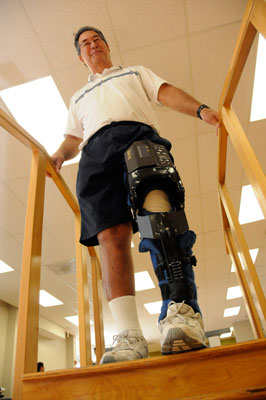Center putting best, bionic foot forward

Reid Kimoto uses a bionic leg to help him walk down makeshift steps at the Rehabilitation Hospital of the Pacific.
Like the fictional technology featured in the 1970s Bionic Woman television show, a bionic leg has become a reality for patients at the state’s only acute-care medical rehabilitation center.
Rehabilitation Hospital of the Pacific is investing hundreds of thousands of dollars in the market’s latest technology, including a wearable robotic device that strengthens the muscles of stroke patients by supporting normal movement and an antigravity treadmill that creates an environment of weightlessness, allowing patients to run, jump and skip where they otherwise couldn’t.
The hospital and its foundation is initially investing about $160,000 to bring new technology to its Innovation Center, including a virtual reality simulator that allows patients to practice driving.
The hospital is seeking to partner with research and development firms to test the latest rehab treatment devices that aren’t readily available on the market, according to the hospital’s manager Teresa Wong.
Along with traditional therapy, the technology can improve patients’ progress in recovery, help retrain their brain after injury and bring about changes in the nervous system, said Nancy Byl, a rehab researcher and physical therapist from the University of California at San Francisco, who is working with the Honolulu hospital on bringing the devices to the islands.
Instead of using electrical impulses to stimulate muscles to move, the technology retrains the brain and muscles to work together, she said.
Don't miss out on what's happening!
Stay in touch with breaking news, as it happens, conveniently in your email inbox. It's FREE!
"Before, with patients who have lived with disabilities, they’ve always been told, ‘There’s nothing more we can do for you,’" she said. "Now with the development of new technologies we can help them in ways we couldn’t help them before. It’s really the ability to change the paradigm of aging."
The 100-bed hospital is one of only a handful of facilities, including Stanford University Medical Center, Columbia University Medical Center, USCF Medical Center and Good Shepherd Rehabilitation Network, using the bionic leg to rehabilitate those with neurological disorders, according to the hospital.
The hospital and its three outpatient clinics in Nuuanu, Aiea and Hilo have nearly 400 employees. The center, which treats more than 5,500 patients a year, generates $44.5 million in annual revenue from patient services.
"The longer you can keep people independent, living at home alone or with family and out of long-term care facilities then the less (taxpayers) are going to have to pay in health care," Wong said.



